Alix Gaytan
Year of birth: April 17, 1993.
Where do you live: El Paso, TX., USA
Your education: Pennsylvania State University, MFA (Painting).
University of Texas at El Paso, BFA (painting and printmaking).
Describe your art in three words: Electrifying, Uncanny, and Bodily.
Your discipline: Painting and Printmaking.
alixgaytan.com | Instagram
Your work prominently features insect-humanoid hybrids in chaotic, fragmented environments. Can you explain the symbolism behind these hybrid creatures and what they represent in your art?
I decided to use the human body and insects together to disrupt the idea of our “normal” bodies. The symbolism and representation behind the insect humanoids are a physical manifestation of a mind whose systems and borders have been fragmented by violence, trauma, or chaos. These acts can disturb the subject’s identity and transform it into something vaguely recognizable. Something that automatically alienates them as they have become abject beings. These new forms threaten everything we are supposed to be and everything that we understand as our wholeness. The boundary between the human and the animal becomes transgressed and then blends to express a disturbing new reality. In essence, I wanted to depict the stage where we are the scariest to ourselves and others and bring it to the spotlight for confrontation. As I wrote in my artist statement, my drive is to offer a visual statement of the durability of the human mind and how the lack of individual and societal stability affects us.
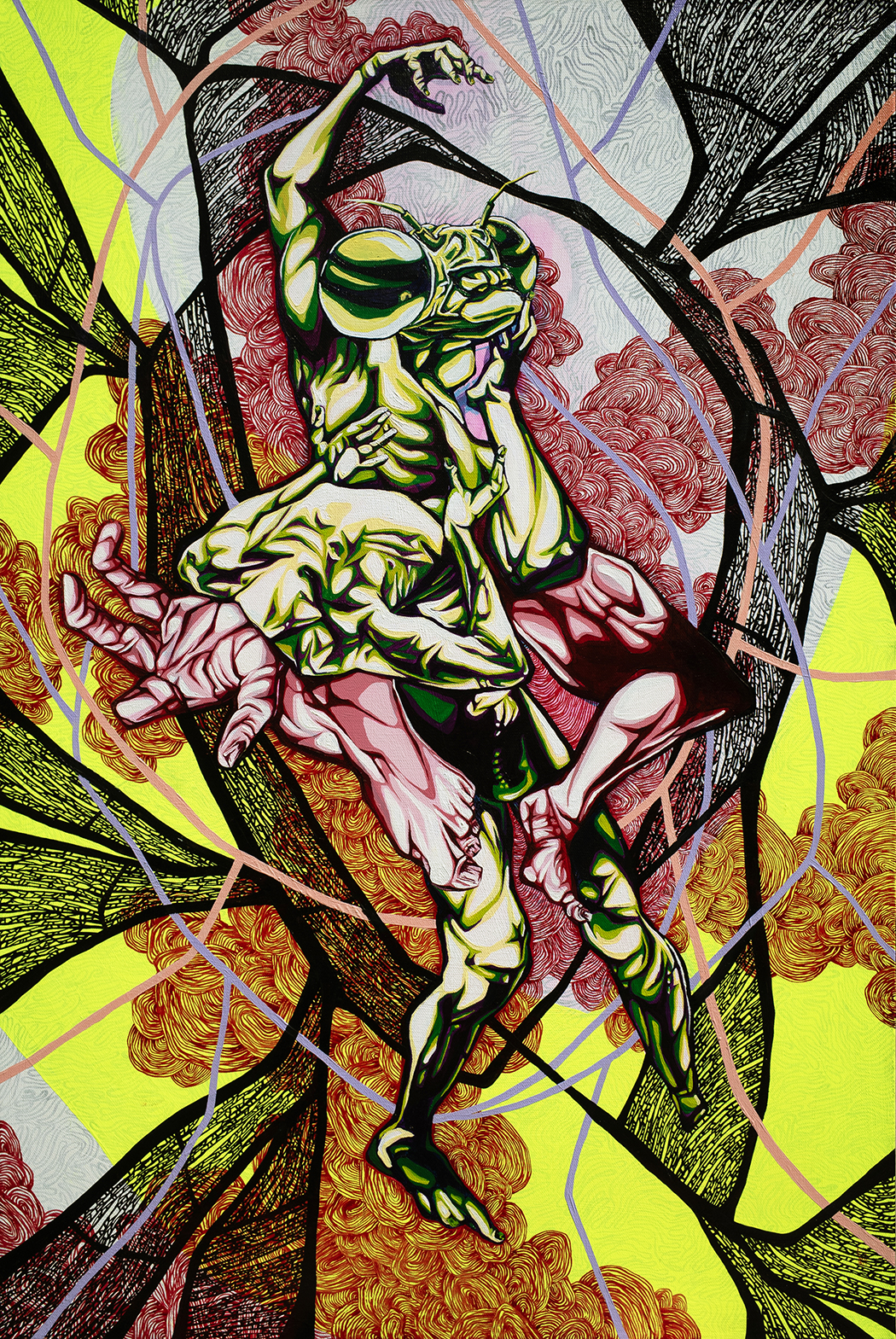 Alix Gaytan | A Place For My Head | 2023
Alix Gaytan | A Place For My Head | 2023
Your artistic journey is deeply connected to your personal experiences growing up in a tumultuous environment. How do your upbringing and the challenges you faced influence the themes and subjects in your work today?
As a child, the TV was my best friend because it was the only way to escape what was happening around me. I loved cartoons, but also, I found myself captivated by horror movies. I remember watching movies from the 70s and 80s, especially Cronenberg or Carpenter. I did not know who they were then, but their characters terrified me just like they hypnotized me. I created a strong connection with the monsters and villains. I recognized them. I saw these strange creatures as the people around me whose life was in chaos. Eventually, I grew out of the fear and became curious to understand why people could act violently or erratically. I wanted to know how our minds can be broken down so much and still be willing to survive. As I started my artistic career, I decided to use horror movie aesthetics or character depiction as the source of my creatures and atmospheres because they were my way of coping with my experiences since childhood. Now, my work involves an even more profound view of the human body and its anatomy as a reflection of chaos in society, not just the individual mind. I am now curious about systems and what happens when they get fragmented, broken, or transgressed. For example, we are a series of constantly moving systems. To me, our bodies are perfect chaos that, at any moment, can fall apart if something goes wrong. The same concept can be applied to society’s systems. We are constantly living in chaos, which is necessary, but at the same time, it can provoke many disasters at any second.
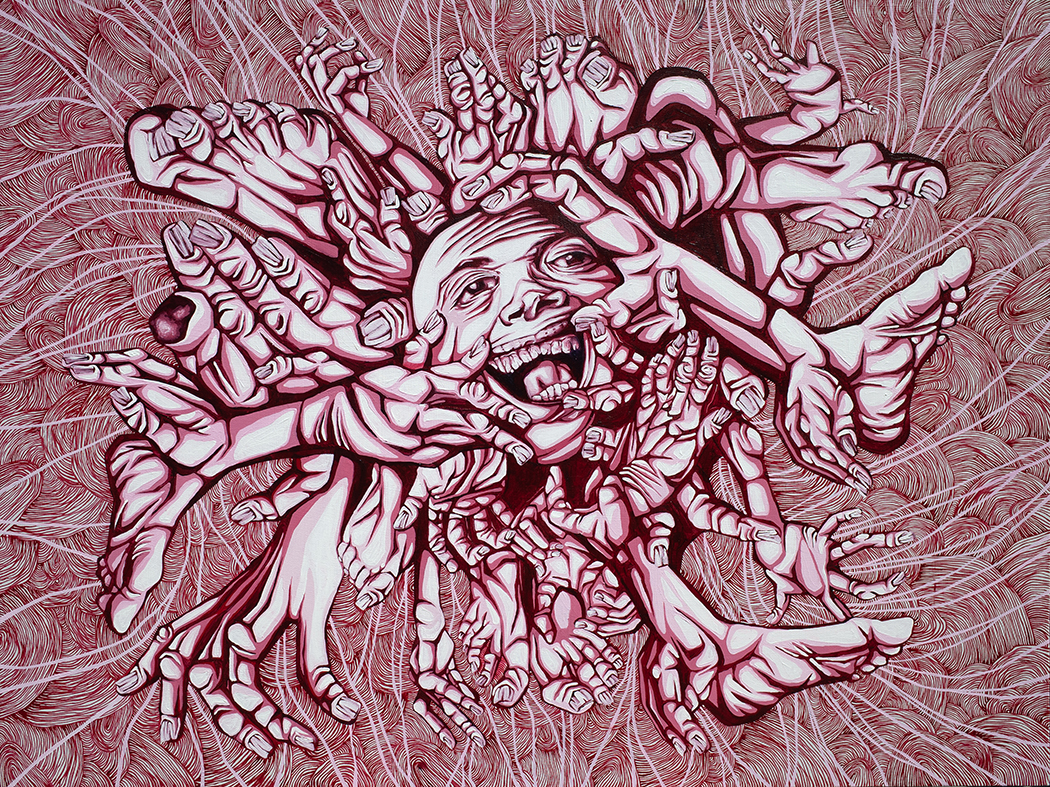 Alix Gaytan | Close Encounters | 2023
Alix Gaytan | Close Encounters | 2023
Your work often blurs the boundaries between human and non-human forms, creating something uncanny. How do you balance creating something that’s recognizable yet unsettling?
I do not focus on any balance between recognizable and unsettling, at least not on a conscious level. When I create my characters, I start by doing small photo collages. I play with the images and leave it up to chance. I love this moment because it is just cutting and pasting. It is almost like being a kid again. There are no rules, main ideas, or expectations. It is liberating. As I start putting cut-outs together, things begin to happen, and eventually, I end up with little versions of my strange creatures. Not all of them make it into paintings, just a few. I choose the ones that have a strong sense of narrative or dramatism. The Renaissance and Mannerist painters influenced my work in the way they dealt with creating narratives with the use of the human body. The position of the body, hands, feet, eyesight, everything contributed to the narrative. This is a characteristic that I am always trying to develop further.
There’s a strong interplay between vibrant colors and disturbing imagery in your work. Can you discuss your approach to color and how it enhances the emotional impact of your pieces?
There are two reasons why I use a lot of color in my work. The first of them is that I adore colors. My artwork, since the very beginning, has been colorful. It makes me feel excited about my compositions. It just brings me joy personally (even though I mostly dress in black). Now, to be more serious, color is the fastest way to attract people’s attention to an art piece, in my opinion. Therefore, I use extravagant color palettes to trap people into looking at my work. The viewer approaches the bright, colorful image and then gets hit by the disturbing imagery. It creates this attraction-repulsion towards the image. This effect connects to the content of my work by emphasizing how we can feel repulsed and attracted by what is different or unknown to us, even if we cannot fully explain this situation.
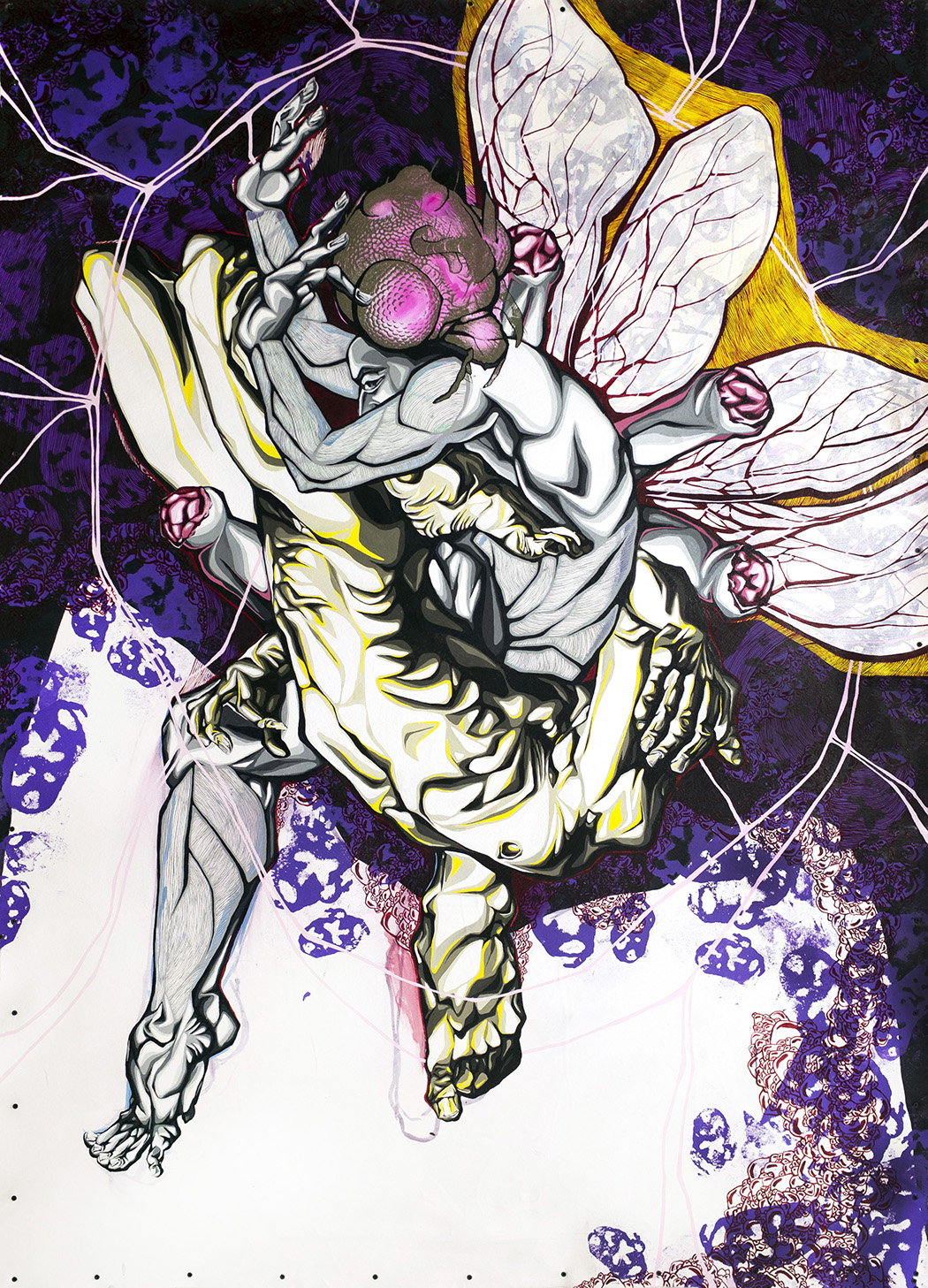 Alix Gaytan | Subject 026 Frustration Please Do Not Stop Hiding | 2021
Alix Gaytan | Subject 026 Frustration Please Do Not Stop Hiding | 2021
How do you want viewers to engage with your work? Are there specific emotional responses you hope to evoke?
I leave this part to the viewer. As the artist, I finished my part by creating the object and putting it out there for people to experience. It is up to the viewer to decide how to engage in or react to my work. I welcome any emotional response. Each person will experience it differently, and I love that. To me, this is the beauty of art. I love to see how we can connect through an image and share our human existence. However, suppose I could control the viewer’s reaction. In that case, I wish they would be curious about the narratives. I like to leave some mystery. I purposely do not give much of the exact story behind each image because I want the viewers to create their own stories and connections. Hopefully, this curiosity will create an introspection about themselves and their relation to others.
You’ve explored various mediums, including painting, drawing, and printmaking. How do you decide which medium is best suited for a particular concept?
I do not choose any medium over another because of the concept. I do not think about concepts early in the making process. I focus on the formal aspects of the images, like lines, patterns, shapes, colors, etc. If the composition does not pierce my interest at an aesthetic level first, then I do not even start to think about concepts or references. As the artwork grows, concepts appear; maybe the image resembles a particular narrative or emotion. Also, it might remind me of something specific about my life experiences. One fact about my practice is that my paintings feed on my print work. My paintings would not progress without my screenprints. Printmaking is the process where I experiment a lot, and it helps me be braver in my paintings. Sometimes, I find compositions, patterns, or layering effects in screenprints that I translate to paintings. Also, my way of handling paint is like how color layering in screenprint works. I separate each color and blend very little. Lastly, when I get stuck or lack motivation, I often do prints just for fun, which then transforms into more serious work, either screenprints or paintings. It is like printmaking is my safe space.
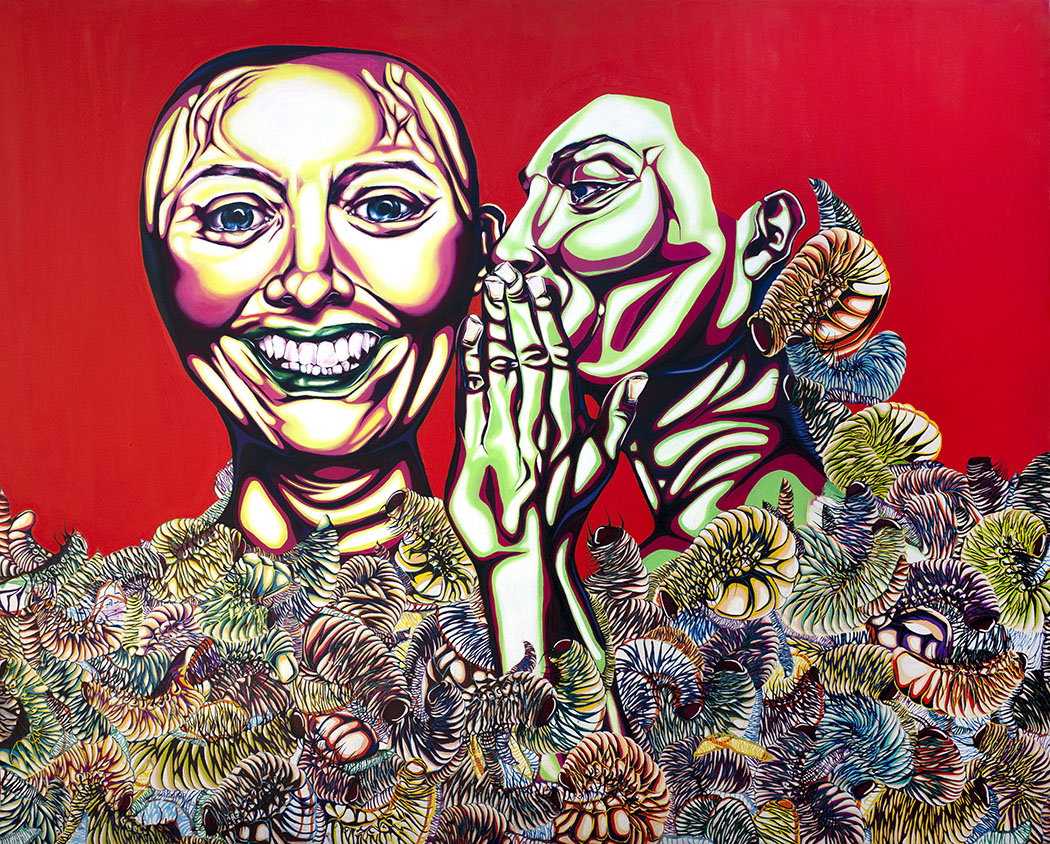 Alix Gaytan | Subject 016 The Frustated Secret Keeper | 2020
Alix Gaytan | Subject 016 The Frustated Secret Keeper | 2020
As both an artist and educator, how do these roles intersect and inform each other in your practice?
I mainly teach art foundation classes at a college level. I meet students who are barely starting their artistic careers. They are scared, anxious, and dealing with all the changes that come with becoming an adult. However, they are also eager to learn and give their all to make something meaningful in their practice. My favorite moments are when they are proud of the artwork that they just created. This contagious excitement reminds me that it is all about progress, not perfection. My students keep me on my toes to continue doing what I love without wavering. Being an educator keeps me motivated as an artist. First, being an art instructor without artistic practice would be strange. I could not teach the students properly or transmit any motivation for art if I did not create artwork myself. They get to see the actual working artist who still struggles to find the answers to her work. I talk to them about my upcoming ideas and exhibitions. I even share with them when plans do not work out and I must start from scratch. They see that this profession is not about overnight success but relatively constant practice and taking advantage of opportunities. Celebrate the small wins and continue pushing forward when rejection occurs. Or that’s what I wish to communicate, at the very least.

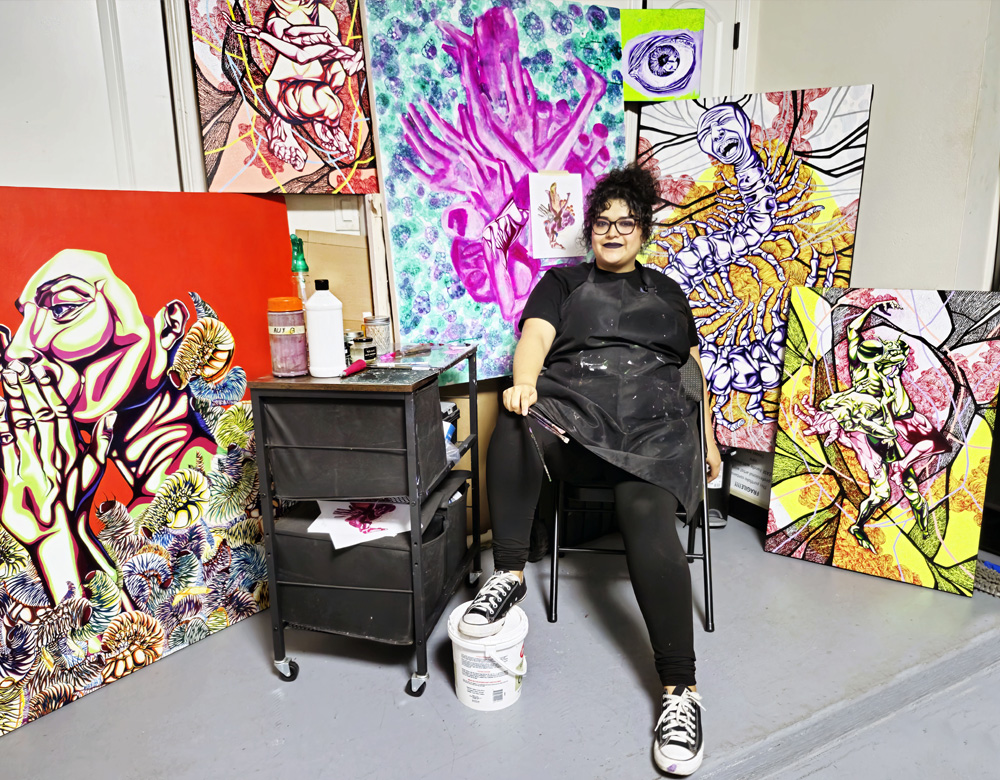
Leave a Reply
You must be logged in to post a comment.